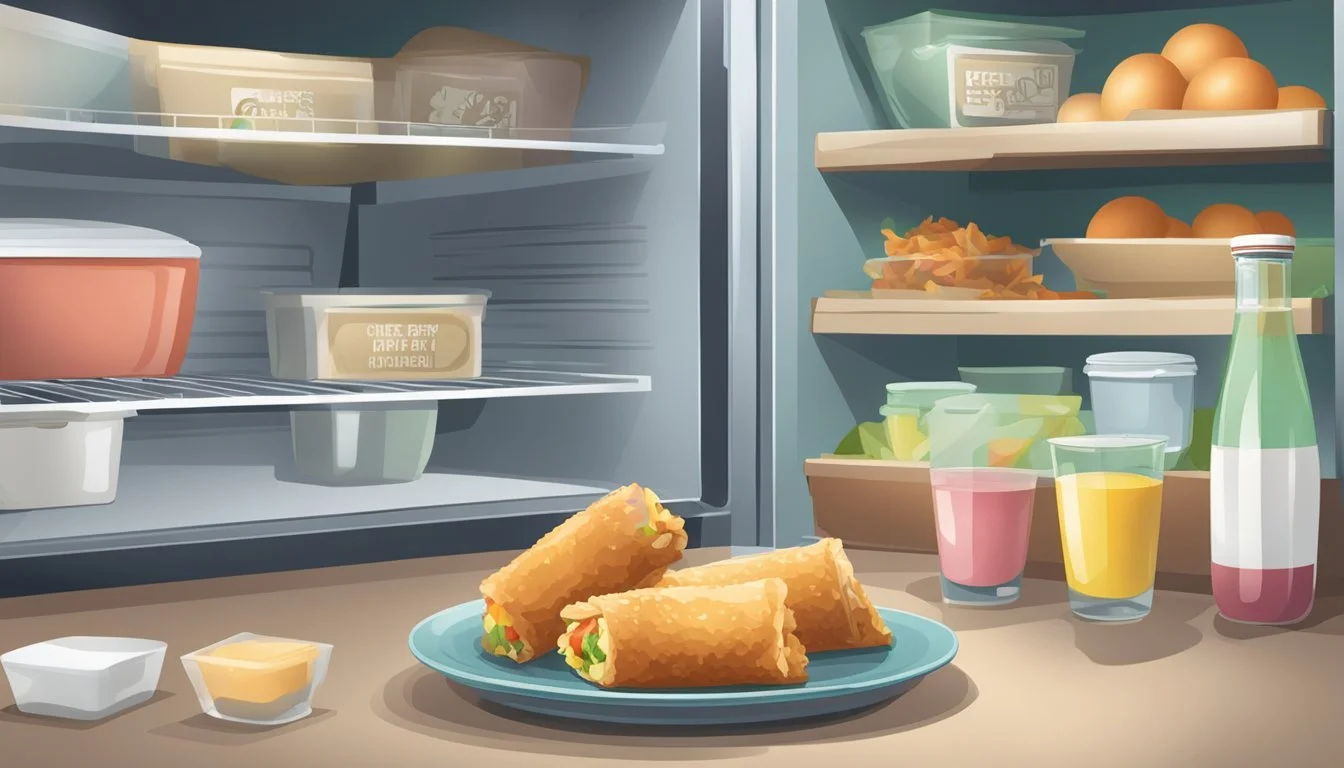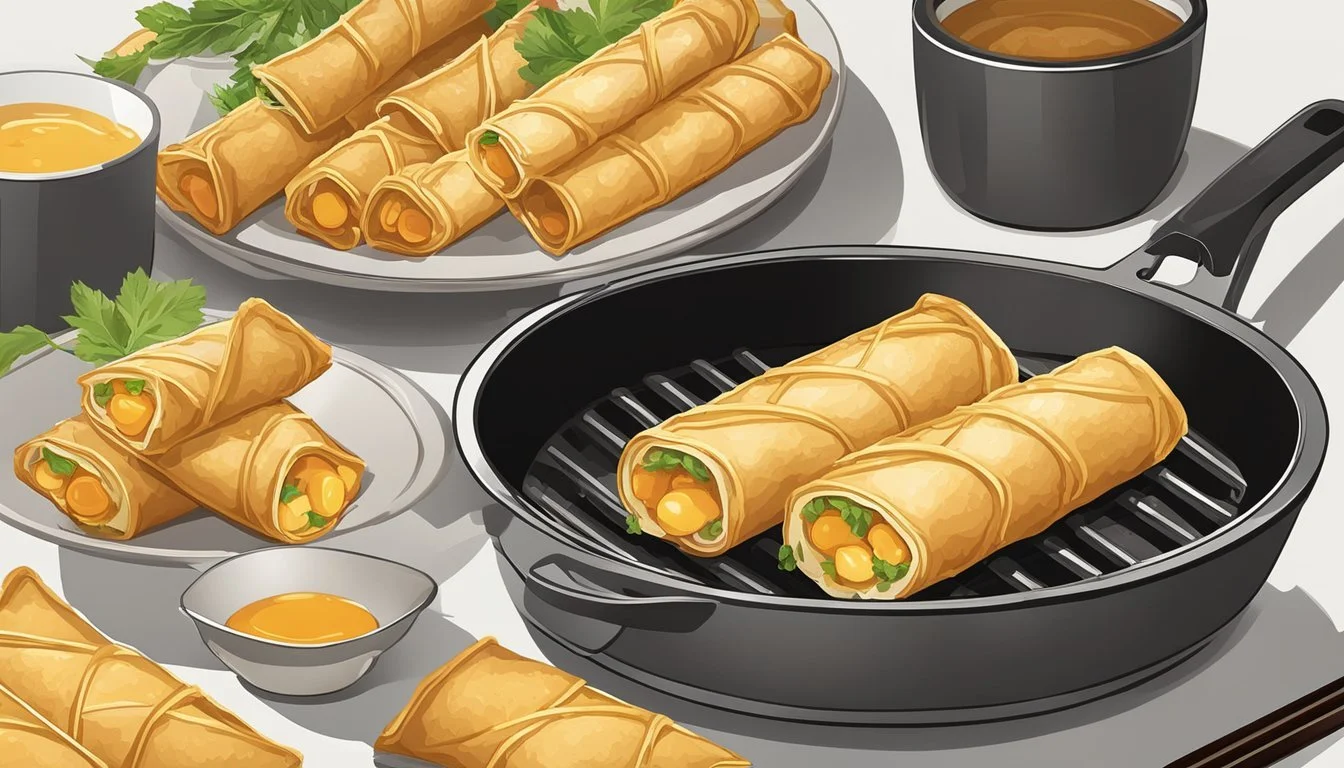How Long Do Chicken Egg Rolls Last?
Storage Tips and Shelf Life
Chicken egg rolls are a popular dish, but many wonder how long they can be enjoyed after they're made. These savory snacks last up to 3-4 days in the refrigerator when stored in an airtight container, maintaining their quality over this period. Freezing can extend their shelf life considerably, keeping them good for up to six months.
Proper storage is key to ensuring the best quality. For uncooked egg rolls, refrigeration extends their shelf life up to one week. Once cooked, refrigerated egg rolls should be consumed within a few days for the best taste and texture.
Whether storing them in the fridge or freezer, keeping egg rolls in airtight containers or resealable bags helps preserve their freshness. To enjoy them at their best, reheat them in an air fryer or oven to restore their crispiness and flavor.
Understanding Egg Rolls
Egg rolls, a staple in Chinese cuisine, come in various forms and are enjoyed worldwide. They have a distinctive crispy exterior and a flavorful filling that varies widely by region and personal taste. Chicken egg rolls, in particular, are popular for their savory blend of ingredients enclosed in a crunchy wrapper.
Components and Varieties
Egg rolls typically consist of a filling enclosed in a wheat-based wrapper. Ingredients often include meat (such as chicken), vegetables like cabbage, carrots, and celery, and seasonings. The filling components can vary, offering a range of flavors.
Varieties of egg rolls differ in fillings and cooking methods. For example, chicken egg rolls are commonly cooked with marinated meat for added flavor. While the traditional Chinese egg roll is the most recognized, variations exist, such as Vietnamese and Filipino versions, each bringing unique regional twists.
Egg Roll Wrapper Specifics
The wrapper of an egg roll is crucial to its texture and taste. Made from wheat flour, water, and eggs, it becomes crispy when deep-fried. Properly handling and storing the wrappers ensures they don’t dry out before use. They are thicker than spring roll wrappers, which are typically made of rice paper and not fried, resulting in a different texture and taste.
Wrappers should be pliable yet sturdy enough to encase the filling without tearing. Ensuring a good seal is essential to prevent the filling from spilling during cooking. The key is to use a bit of water or egg wash on the edges before rolling them up tightly.
Cultural Significance
Egg rolls hold a special place in Chinese food culture, often served as an appetizer, side dish, or even a snack during various celebrations and meals. They symbolize wealth and prosperity, especially during Lunar New Year festivities.
The difference between egg rolls and spring rolls is not just in the wrapper but also in their cultural roles. While spring rolls are enjoyed throughout East and Southeast Asia, egg rolls are particularly entrenched in American Chinese cuisine, becoming a beloved feature of Chinese takeout menus.
By recognizing these differences and appreciating the variety of egg rolls, one can better understand the cultural and culinary landscape they inhabit.
Proper Storage Techniques
Proper storage can extend the lifespan of chicken egg rolls, ensuring they remain fresh and delicious. Whether you plan to eat them soon or later, specific methods will keep them in good condition.
Refrigerating Egg Rolls
To keep egg rolls fresh for up to 3-4 days, store them in the refrigerator. Ensure your refrigerator's temperature is set between 35°F (1.6°C) and 40°F (4.4°C).
First, place the egg rolls in an airtight container. This prevents exposure to moisture and odors from other foods. For added freshness, wrap each egg roll in plastic wrap or aluminum foil before placing them in the container. This additional layer helps maintain their texture and flavor.
Check on the egg rolls daily. If they develop a strange smell or texture, it's best to discard them. Consuming them within the recommended timeframe keeps them safe and enjoyable to eat.
Freezing Egg Rolls
For longer storage, freeze your egg rolls. This method can keep them good for up to 1-2 months. Before freezing, allow the egg rolls to cool down completely to avoid condensation inside the packaging.
Wrap each egg roll tightly in plastic wrap or aluminum foil. Then, place them in a freezer bag or airtight container. Ensure all the air is expelled from the freezer bag to prevent freezer burn.
Label the packages with the date to keep track of their storage time. When ready to eat, reheat them directly from frozen without thawing to maintain texture and quality. Use an oven or air fryer for the best results, as microwaving can make them soggy.
Determining Freshness and Spoilage
Identifying the freshness of chicken egg rolls involves observing specific visual and olfactory indicators. Understanding these signs helps avoid health risks associated with consuming spoiled egg rolls.
Visual and Olfactory Indicators
Fresh egg rolls exhibit a crispy, well-folded exterior without any discoloration. Appearance is key: the wrapper should remain a consistent golden-brown hue. Any dark spots or unusual coloring could signal spoilage.
Texture plays a critical role too. Fresh egg rolls maintain a firm, slightly crisp texture when fresh. A soggy or overly dry wrap indicates spoilage.
Smell is another crucial point. Fresh egg rolls have a neutral, slightly savory aroma. An off odor, such as a sour or acrid smell, is a clear sign of spoilage and the egg rolls should be discarded immediately.
Health Risks of Spoiled Egg Rolls
Consuming spoiled chicken egg rolls poses significant health risks. Bacterial contamination from improper storage can lead to foodborne illnesses.
Key signs of spoilage include an unpleasant smell, visible mold, or a slimy texture. These symptoms suggest bacteria such as Salmonella or E. coli may be present.
To mitigate health risks, follow the proper shelf life guidelines: at room temperature, they last no more than 2 hours; refrigerated, they last up to 4 days. Monitoring for signs of spoilage ensures egg rolls are safe to eat.
Guidelines for Reheating and Serving
Reheating chicken egg rolls can be done effectively using various methods to maintain their crispy texture and desirable flavor. Each approach offers distinct advantages, ensuring your egg rolls remain delicious and satisfying.
Oven-Based Reheating
Preheat the oven to 350°F (180°C). Arrange the egg rolls on a baking sheet in a single layer. Optionally, use a wire rack for better air circulation.
Tips:
Timing: Bake for 10-15 minutes.
Crispness: Halfway through, flip the egg rolls for even crisping.
Extras: Brush with olive oil for extra crunch.
Oven heating is especially effective in maintaining the crispy exterior of the egg rolls while thoroughly warming the inside without overcooking.
Microwave Reheating and Textural Considerations
Microwave reheating can be quick but may affect texture. Use a microwave-safe plate and cover egg rolls with a damp paper towel to retain moisture.
Steps:
Settings: Use medium power.
Duration: Heat for 1-2 minutes.
Improvement: Optionally, move to an oven at 350°F for 5 minutes after microwaving to enhance crispiness.
This method is ideal for those in a hurry but wanting a balance between speed and texture. However, it may not achieve the same crispness as ovens or air fryers.
Using an Air Fryer for Reheating
Preheat the air fryer to 350°F (175°C). Place the egg rolls in the basket without overcrowding, allowing hot air to circulate freely.
Key Points:
Cooking Time: Heat for 5-7 minutes.
Turn Over: Flip halfway through to ensure even browning.
Result: Achieves a crispy outside and a warm interior.
Air fryers provide an optimal balance of quick reheating and preserving the original texture, often yielding results close to freshly cooked egg rolls.
Safety Tips and Consumption
To ensure that chicken egg rolls are safe to eat and remain healthy, it’s important to follow proper storage and consumption guidelines. Awareness of bacteria growth and potential contamination is crucial to prevent foodborne illnesses.
Preventing Contamination
Proper storage of chicken egg rolls is key to preventing contamination. They should be refrigerated within two hours of cooking. Leftovers should be kept in airtight containers to reduce exposure to bacteria.
If temperatures exceed 90°F, refrigerate them within one hour. Make sure your refrigerator is set to 40°F or below. Using clean utensils and surfaces when handling egg rolls also minimizes risk.
In terms of preparation, ensure that chicken is fully cooked. Raw chicken must reach an internal temperature of 165°F to kill harmful bacteria. Avoid cross-contamination by keeping raw and cooked egg rolls separate.
Recognizing Unsafe Egg Rolls
Knowing how to identify unsafe egg rolls can prevent foodborne illnesses. Egg rolls should not be left out at room temperature for more than two hours. Watch for signs of spoilage such as an off smell, unusual texture, or mold.
Frozen egg rolls can keep for up to six months but should be checked for freezer burn. If egg rolls show any signs of thawing and refreezing, discard them.
The expiration date on store-bought egg rolls is also critical. Consuming egg rolls past their expiration date increases the risk of food poisoning. Always reheat leftovers to at least 165°F before consuming to kill any lingering bacteria.
Maximizing Taste and Texture
Achieving the best taste and texture in chicken egg rolls involves careful preparation and cooking methods. This includes techniques for frying to maintain crispiness and selecting ingredients that enhance flavor.
Frying for Optimal Crispiness
Frying chicken egg rolls correctly is crucial for achieving that signature crispy exterior. Heat the oil to between 350°F and 375°F (175°C to 190°C) for optimal results.
Lower the egg rolls gently into the hot oil. Fry them for about 2-3 minutes until they become golden brown.
Use a deep fryer or large saucepan filled with oil. Ensure the oil fully covers the egg rolls for even frying.
Drain the cooked egg rolls on a wire rack or paper towels to remove excess oil, which helps maintain texture.
Reheating fried egg rolls in an air fryer or oven at a high temperature helps revive their crispiness without making them greasy.
Ingredients Impact on Flavor
Selecting the right ingredients is key to ensuring your chicken egg rolls taste delicious. Fresh chicken, properly seasoned, forms the base of great flavor.
Add finely chopped vegetables such as cabbage, carrots, and onions. These not only enhance taste but also provide texture contrasts.
Season the filling with salt, pepper, and a bit of sugar for a balanced flavor profile. Using soy sauce or oyster sauce can add depth.
To prevent spoilage, always use fresh ingredients and store unused portions in airtight containers in the refrigerator.
Avoid overly wet ingredients, as they can make the rolls soggy. Instead, toss vegetables briefly in a hot pan to remove extra moisture before wrapping.
Extending Shelf Life
Proper storage techniques can significantly extend the shelf life of chicken egg rolls. By freezing and handling them correctly, one can enjoy the delicious treats longer and maintain their quality.
Freezing Homemade vs. Store-Bought Egg Rolls
Homemade and store-bought egg rolls can both be frozen to extend their shelf life, but the methods may differ slightly. For homemade egg rolls, it’s essential to let them cool completely before wrapping each roll in heavy-duty aluminum foil or plastic wrap. Once wrapped, place them in an airtight container or a Ziploc bag to prevent freezer burn.
Store-bought egg rolls often come pre-packaged, making it easier to freeze them directly in their packaging. Checking the packaging for any gaps or openings is crucial as exposure to air can lead to freezer burn. If necessary, rewrap the egg rolls or place them in an airtight container for added protection.
Thawing and Refreezing Considerations
Thawing chicken egg rolls should be done carefully to maintain their quality and safety. The best way to thaw them is by moving them from the freezer to the fridge, allowing them to thaw slowly. This method helps prevent excess water buildup and sogginess.
Once thawed, egg rolls should be reheated in the oven or air fryer for a crisp texture. It is not advisable to refreeze egg rolls after they have been thawed, as this can affect their texture and flavor. Repeated freezing and thawing cycles can lead to freezer burn and deteriorate the overall quality.
Additional Tips and Tricks
Improving chicken egg rolls at home, using leftovers in creative ways, and ensuring you shop for quality ingredients can enhance your meal experiences significantly. These tips will optimize your effort and make sure you get the best results.
Improving Homemade Egg Rolls
Making delicious homemade egg rolls starts with gathering fresh ingredients. Fresh carrots, cabbage, and ground chicken are essential. Use a good quality soy sauce and some pepper to season your filling. When making egg rolls, a few tricks can help:
Use parboiled cabbage: This can help avoid a soggy filling.
Avoid overfilling: This will prevent the egg rolls from bursting.
Sealing edges: Use a well-moistened corner to seal the rolls tightly.
Baking Sheet and Parchment Paper: Line your baking sheet with parchment paper to avoid sticking and promote even cooking.
Utilizing Leftovers Creatively
Leftover chicken egg rolls can be repurposed into new, exciting meals. Here are a few ideas:
Reheating: For a crisp texture, reheat in an oven preheated to 350°F on a baking sheet lined with parchment paper.
Stir-fry: Cut leftover egg rolls and add to a vegetable stir-fry with shrimp, beef, or more ground chicken.
Salads: Chop the egg rolls and toss them into a fresh green salad with cheese, cabbage, and carrot shavings.
Soup: Slice the egg rolls into thin strips and add them to a hot broth for a quick egg roll soup.
Shopping for Quality Ingredients
Purchasing quality ingredients is paramount for achieving the best taste and freshness in your egg rolls. When shopping:
Visit supermarkets known for their fresh produce and meats.
Look for fresh, vibrant cabbage and carrots without bruises or discoloration.
Opt for fresh ground chicken or consider shrimp and beef as alternative fillings.
Always check expiration dates on ingredients like soy sauce and other seasonings.
Choose the right type of egg roll wrappers, ideally those with minimal preservatives.
A careful selection of ingredients will not only improve the taste but also enhance the nutritional value of your chicken egg rolls.









